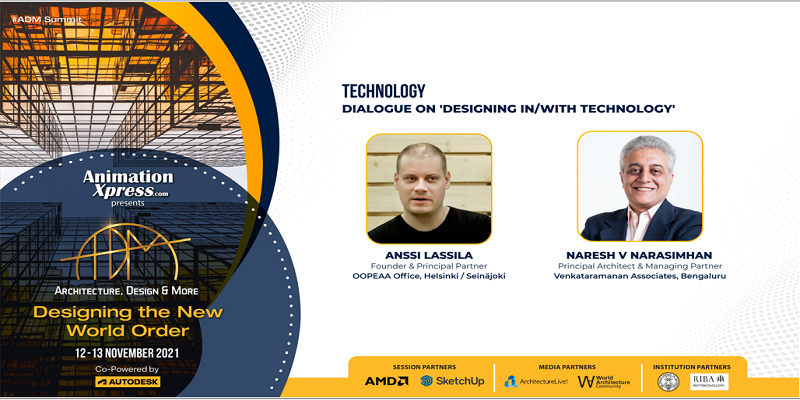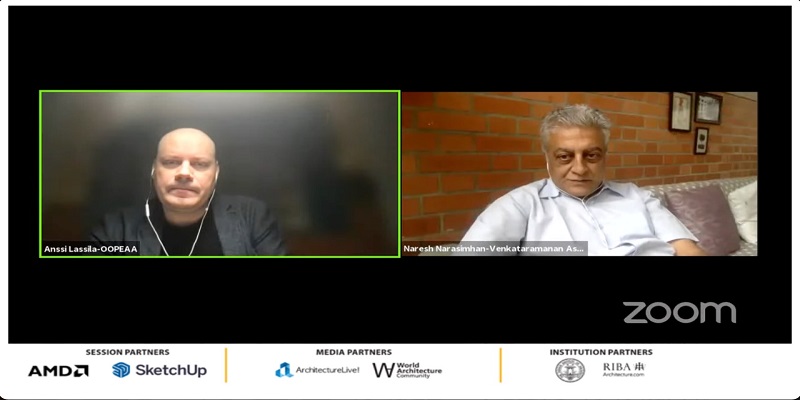
What will the future city look like? With the rising pollution bolstering global warming and the increase of carbon particles in the air, it is questionable whether we will have a healthy environment to live and breathe in. And to a certain extent we are responsible for it.
How to manage this risk? Is there any solution? If we have pushed our lives to an extent where Covid-19 pandemic stalled all of our lives around the world, at the same time we are the ones who figured out its solution and invented its vaccine. So the solution is in our hands and by making smart choices which are ecologically friendly, we can save the mother earth and enjoy a sustainable living. Tapping on the same point, it was time for the ADM Summit’s next session ‘Designing in/with Technology’ and it commenced with the dialogue between OOPEAA Office founder and principal partner Anssi Lassila from Helsinki/Seinäjoki and Venkataramanan Associates principal architect and managing partner Naresh V Narasimhan from Bengaluru.
The dialogue opened with a presentation by Lassila where their project Puukuokka housing block helped to reduce carbon emissions. Carbon emissions from wood building is 14 per cent whereas from concrete it is 66 per cent.
“Puukuokka Housing block offers homes for 184 households; from single dwellers of all ages to families with children. Wood has been used instead of concrete and all buildings were successful and the user feedback was very positive. There will be more competition for wood apartments. There will also be more technical developments in wooden buildings,” he added.
Today 35 per cent of the total greenhouse gas emissions come from construction companies. Architects need to find more effective and better ways to design structures and that’s where technology and sustainability comes in.
They further made calculations on why people liked their wooden apartment block and why they would prefer taking it. The results were as follows – 81 per cent will take because of location, rent and appearance, 51 per cent because it is a wooden apartment , 98 per cent because of the fire safety they felt safe with a sprinkler system , 75 per cent because of its ecological impact.
Following the presentation, Narasimhan asked, “To be able to analyse what they do in a very clever way, architects today have a lot of access to analysis and data. But then how is it that architects are the last ones to adopt technology to innovate, whereas other industries seem to move much faster?”
To this, Lassila replied that when architects talk about nature, they imitate nature or try to repeat things that have been done before. “Maybe with technology we can learn how nature works and can find ways to do things in the future. Now we have 100 years of experience making things with nature. We don’t want to copy the shapes or rather we don’t want to create nature that looks like architecture. We will try to understand how nature is behaving, hoping or working and try to find out the solution to offer.”
Cop26, a conference in Glasgow, which is going on has addressed climate change impacts on the world. One of the phrases that has been used is called ‘carbon colonisation’, Narasimhan shared. It is true that the whole world is transitioning to adopt a low carbon future and we shouldn’t take carbon embedded from the ground (like we do in petroleum, gasoline products) and release that carbon up in the atmosphere. Instead we should look for alternate technologies which are more carbon neutral and may be direct conversions.
“Solar power itself comes from solar cells which are made using power from thermal power plants which may use coal. At some point in architecture and construction materials, we have to radically reimagine and find ways in which we can stop releasing embedded carbon back into the atmosphere as carbon dioxide,” Narasimhan cited this example.
Lassila believes that a lot of damage has been done and they are in a place where they should do things in different ways to sustain since humans are not left with many options. Which means, western countries are really under the responsibility to show the directions how to do things in a better manner and he hopes that if all crises open up, there will be new possibilities to develop solutions.
“Economical solutions brings in business opportunities. Environmental challenges are not only a problem but it also brings a possibility to create a better solution for the future. It goes the same with the Indian perspective as well.If you have a great sustainable solution then it will have great business opportunities for the future market,” Lassila added.
Another important aspect that Narasimhan pointed out is that today, on one hand, a lot of technical tools are accessible to optimise designs. On the other hand, the main problem is that people are trying to build much bigger houses than they actually require for living because of which the idea of wastage increases. In fact people in India are building very big houses in an unsustainable way. “Take the example of space exploration and how people are working on designing how to live on the moon, Mars and so on. Here we learnt how to make use of the same space to store and use energy, find balance between work and play, get that daily exercise in a controlled environment and much more,” Narasimhan shared.
Lassila also added that humans are behaving with no limitations. If the houses are well planned, the design is excellent giving justice to the space, and works effectively, then we don’t require a bigger space. Lassila also believes that architects are also making some kind of mistake globally as they are offering the same solutions everywhere without any innovation or customisation. It is essential to take local possibility and local climate under consideration while working on a project.
He further said that it is also essential to use the local materials to construct the housing because that becomes cost effective and sustainable to the climate. Overall the session offered a handful of insights which might help to build a better and sustainable future.
